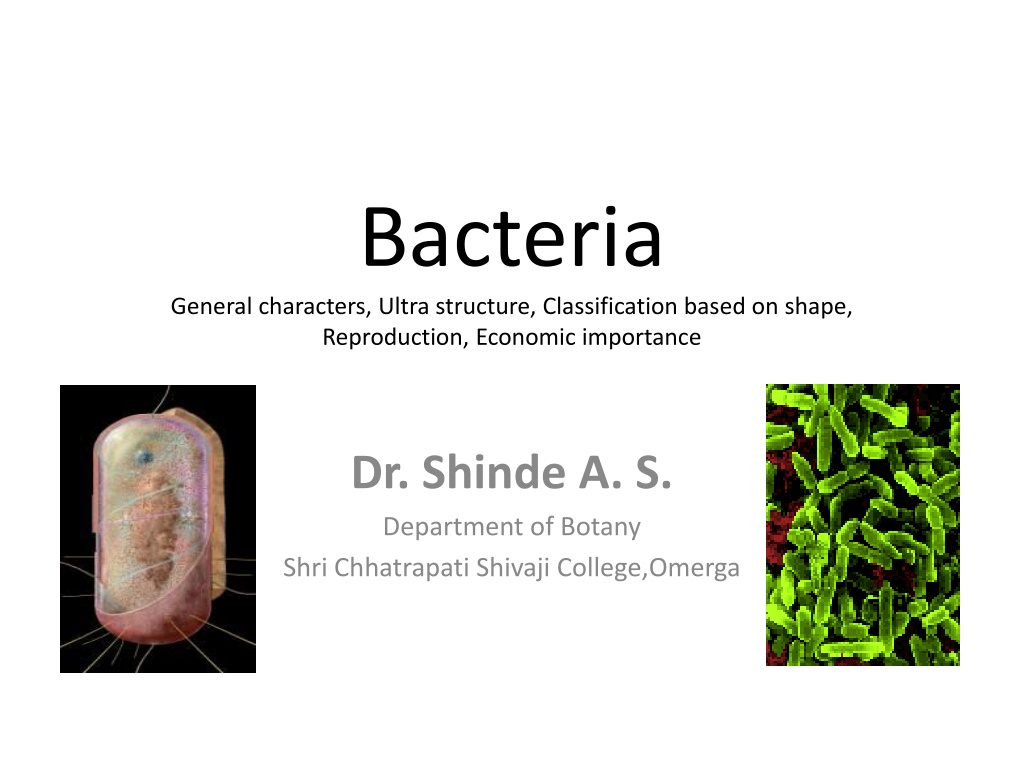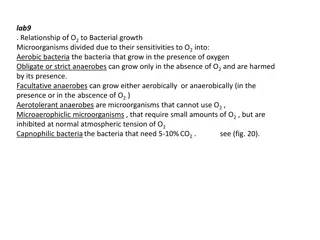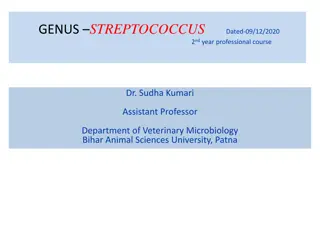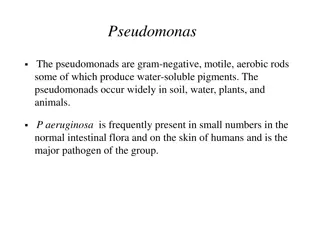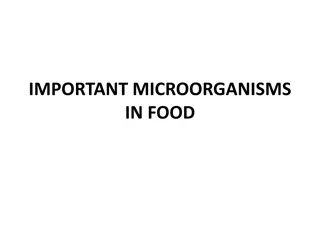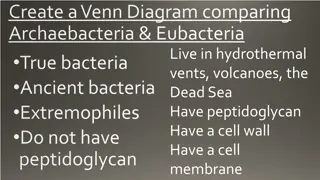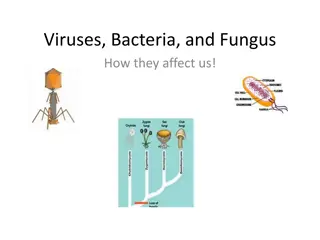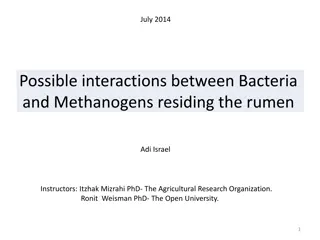Understanding Bacteria: General Characteristics and Economic Importance
Bacteria are ubiquitous microorganisms found in various environments, with some living as commensals or symbionts while others causing diseases. They are characterized by their small size, absence of a nucleus, and diverse classifications such as prokaryotes, eukaryotes, cyanobacteria, and archaebacteria. Their classification, ultrastructure, shapes, reproduction, and economic significance are discussed in detail.
Download Presentation

Please find below an Image/Link to download the presentation.
The content on the website is provided AS IS for your information and personal use only. It may not be sold, licensed, or shared on other websites without obtaining consent from the author. Download presentation by click this link. If you encounter any issues during the download, it is possible that the publisher has removed the file from their server.
E N D
Presentation Transcript
Bacteria General characters, Ultra structure, Classification based on shape, Reproduction, Economic importance Dr. Shinde A. S. Department of Botany Shri Chhatrapati Shivaji College,Omerga
Introduction Bacteria are omnipresent. They are found in all environments, where organic matter is present. Some of the bacteria live as commensals (e.g. Escherichia coli in the human intestine) and some live as symbionts (eg. Rhizobium) in the root nodules of leguminous plants. Several of them cause diseases in plants, animals and human beings. Bacteria are very small, most being approximately 0.5 to 1 micron in diameter and about 3 to 5 microns in length
Prokaryotes Cells that do not have a nucleus Exist almost every where on earth Grow in numbers so great you can see them with the unaided eye Are placed in either the Eubacteria or the Archebacteria Kingdoms Make up the smaller of the two kingdoms
Eukaryotes Make up the larger of the two prokaryote kingdoms Generally are surrounded by a cell wall composed of complex carbohydrates
Cyanobacteria Photosynthetic bacterium Bluish-greenish color Contain membranes that carry out the process of photosynthesis Do not contain the same type of chloroplasts as plants do This bluish-greenish algae can be found nearly everywhere on earth. Can survive in extremely hot environments and even extremely cold environment
Archaebacteria Lack important carbohydrate found in cell walls Have different lipids in their cell membrane Different types of ribosomes Very different gene sequences Archaebacteria can live in extremely harsh environments They do not require oxygen and can live in extremely salty environments as well as extremely hot environments.
Classification of bacteria Prokaryote7
Nutrition Autotrophs Make their own energy Using Solar energy Eg. Cyanobacteria Chemotrophs Make own Energy Using Chemical energy Eg. Archaebacteria Hetertrophs Obtain food By eating Eg. E-coli
Bacteria Respiration Obligate Anaerobes Facultative Anaerobes Obligate Aerobes Live without Oxygen Can live with or without oxygen Cannot live without oxygen.
Reproduction Cellular organism copies it s genetic information then splits into two identical daughter cells
Reproduction Conjugation A type of Bacteria Sex Two organism swap genetic information, that contains the information such as a resistance to penicillin
Reproduction A type of dormant cell Exhibit no signs of life Highly resistant to environmental stresses such as: -High temperatures -Irradiation -Strong acids -Disinfectants Endospores are formed by vegetative cells in response to environmental signals that indicate a limiting factor for vegetative growth, such as exhaustion of an essential nutrient.
Economic Importance 1. Diseases caused by bacteria in plants: Host Citrus Rice Cotton Pears Carrot 2. Diseases caused by bacteria in animals : Sheep Cattle Sheep,goat 3. Diseases caused by bacteria in human beings: Cholera Typhoid Tuberculosis Disease Citrus Canker Bacterial blight Angular leaf spot Xanthomonas malvacearum Fire blight Pseudomonas solanacearum Soft rot Erwiinia caratovora Causal Pathogen Xanthomonas citrii Xanthomonas oryzae Anthrax Brucellosis Brucellosis Bacillus anthracis Brucella abortus Brucella melitensis Vibrio cholerae Salmonella Typhi Mycobacteriam tuberculosis
Economic Importance Sewage disposal Decomposition of plant and animal remains Soil fertility Recycling of matter Dairy Industry Lactic acid bacteriaStreptococcus lactis Convert milk into curd, yoghurt (Lactobacillus bulgaricus) and cheese (Lactobacillus acidophobus). Vinegar Acetobactoraceti Alcohols and Acetone Curing of tobacco, tea and coffee Retting of fibers Antibiotics Vitamins B. thuringiensis infect and kill the caterpillars of some butterflies and related insects.
